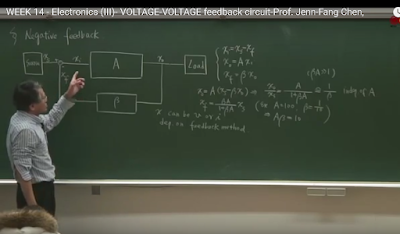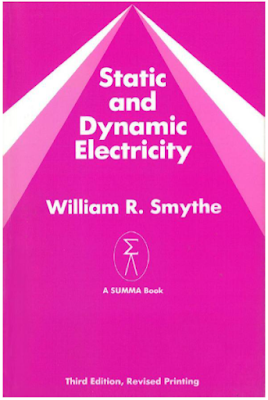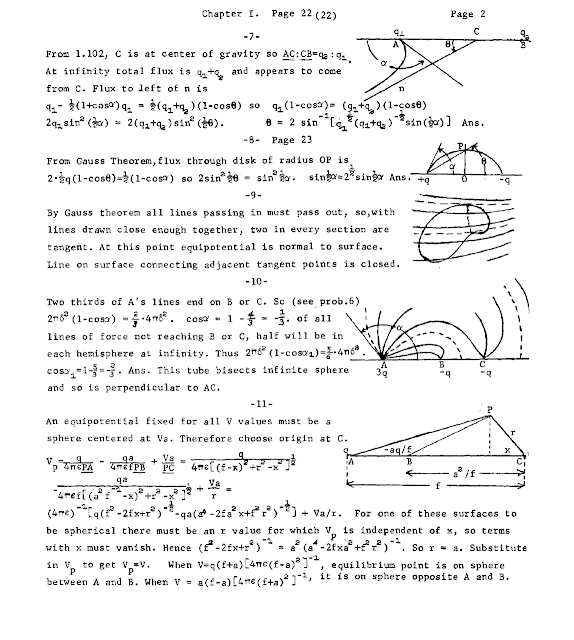quinta-feira, 25 de agosto de 2016
WEEK 14 - Electronics (III)- VOLTAGE-VOLTAGE feedback circuit-Prof. Jenn-Fang Chen-Department of Electrophysics NATIONAL CHIAO TUNG UNIVERSITY
quarta-feira, 24 de agosto de 2016
Electronics (III)-Chapter 6 Cascode circuits-Prof. Jenn-Fang Chen, Department of Electrophysics-NCTU
terça-feira, 23 de agosto de 2016
domingo, 14 de agosto de 2016
Solutions Manual Static and Dynamic Electricity 3rd Edition William R. Smythe
Solutions to Problems in STATIC AND DYNAMIC ELECTRICITY by William R. Smythe INTRODUCTION
Solutions of the 679 problems propounded on 114 pages of the 1968 third edition of Static and Dynamic Electricity (McGraw Hill) are given in the next 178 pages. The second edition has 581 of these, including all in the first, second, third and last chapters. When chapter, page or problem number differs, the second edition value appears in parenthesis. Some of the new problems cannot be solved by the second edition theory. The text problem statement, which lists special assumptions made, defines new symbols used, usually gives the answer and points out text formulas that apply, is not repeated herein. The use of the Handbook of Mathematical Functions and other recent works listed after Chapter V greatly shortens some of the original solutions. Beginning on page 179 is a list of errata of the first printing of the third edition.
LINK ORIGINAL EN LA WEB
http://dl1.ponato.com/eb1/531__4b995e8.pdf
LINK ALTERNATIVO
http://www.mediafire.com/download/fjqt3ef53newfc5/Solutions_to_Problems_in_STATIC_AND_DYNAMIC_ELECTRICITY.pdf
Static and Dynamic Electricity by William R. Smythe (VERSION ENGLISH AND RUSSIAN) - ЭЛЕКТРОСТАТИКА и ЭЛЕКТРОДИНАМИКА - В. СМАИТ
ENGLISH VERSION
Static and Dynamic Electricity by William R. Smythe William R. Smythe Static and Dynamic Electricity McGraw-Hill Book Company Inc. 1950 ( International Series in Pure and Applied Physics )
LINK ORIGINAL EN LA WEB LO PUEDES DESCARGAR GRATUITAMENTE
https://archive.org/details/StaticAndDynamicElectricity
LINK DIRECTO
https://archive.org/download/StaticAndDynamicElectricity/Smythe-StaticAndDynamicElectricity.pdf
RUSSIAN VERSION Электростатика и электродинамика (В.Смайт)
LINK
http://www.mediafire.com/download/o91d46emmvvyawy/Smythe_E%27lektrostatika_i_e%27lektrodinamika.pdf
Static and Dynamic Electricity by William R. Smythe William R. Smythe Static and Dynamic Electricity McGraw-Hill Book Company Inc. 1950 ( International Series in Pure and Applied Physics )
LINK ORIGINAL EN LA WEB LO PUEDES DESCARGAR GRATUITAMENTE
https://archive.org/details/StaticAndDynamicElectricity
LINK DIRECTO
https://archive.org/download/StaticAndDynamicElectricity/Smythe-StaticAndDynamicElectricity.pdf
RUSSIAN VERSION Электростатика и электродинамика (В.Смайт)
LINK
http://www.mediafire.com/download/o91d46emmvvyawy/Smythe_E%27lektrostatika_i_e%27lektrodinamika.pdf
sábado, 13 de agosto de 2016
Signal Flow Analysis: The Commonwealth and International Library: Electrical ...Por J. R. Abrahams,G. P. Coverley ( VERSION ENGLISH AND RUSSIAN) Абрахамс Дж., Каверли Дж. Анализ электрических цепей методом графов. 1967
VERSION ENGLISH
Signal Flow Analysis: The Commonwealth and International Library: Electrical ...Por J. R. Abrahams,G. P. Coverley
LINK GOOGLE BOOK
https://books.google.com.br/books?id=C4ujBQAAQBAJ&lpg=PP1&hl=pt-BR&pg=PP1#v=onepage&q&f=false
VERSION RUSSIAN Абрахамс Дж., Каверли Дж. Анализ электрических цепей методом графов. 1967
LINK EN LA WEB
Signal Flow Analysis: The Commonwealth and International Library: Electrical ...Por J. R. Abrahams,G. P. Coverley
LINK GOOGLE BOOK
https://books.google.com.br/books?id=C4ujBQAAQBAJ&lpg=PP1&hl=pt-BR&pg=PP1#v=onepage&q&f=false
VERSION RUSSIAN Абрахамс Дж., Каверли Дж. Анализ электрических цепей методом графов. 1967
LINK EN LA WEB
sexta-feira, 12 de agosto de 2016
quinta-feira, 11 de agosto de 2016
A Study on the Hybrid UPS with Electrical Energy Storage Function EES 기능을 갖는 하이브리드 UPS에 관한 연구 -2014 Seung-Beom Lim Department of Electrical Engineering Graduate School, Dankook University
A Study on the Hybrid UPS with Electrical Energy Storage Function EES 기능을 갖는 하이브리드 UPS에 관한 연구 -2014 Seung-Beom Lim Department of Electrical Engineering Graduate School, Dankook University
ABSTRACT
EES(Electrical Energy Storage) is the system which stores the remaining energy during the time of light load or night time with the cheap electricity price, and then discharges the stored energy during the time of peak load or electric power shortage. This system improves usage efficiency and stabilizes the power supply system. UPS(Uninterruptible Power Supply) can be divided into three parts according to dependency between input and output voltage : Passive-Standby, Line-Interactive, and Double-Conversion. Double- Conversion type UPSs are used to supply the stable power to industrial high-tech/medical equipments and finance/data centers, where loads are sensitive to the blackout and voltage fluctuation.
In this paper, it is proposed a double-conversion hybrid UPS with EES function. The proposed hybrid UPS is operating in four states, which are normal state, battery state, bypass state, and EES state.
When the AC input source is normal, the system operates in normal state which supplies the stable power to the load through the PFC and inverter, and charges batteries simultaneously. In case of black out or unstable input, the system operates in battery state which supplies the energy from the batteries to the load. In bypass state in case of overload or failure of the inverter, the system supply the input power to the load directly. When the system is needed to operate in EES state, AC input is cut off by the user command and the energy stored in the batteries is supplied to the load. Thereby the system can manage the power efficiently and make the power system more stable. The proposed system is composed of a rectifier, an inverter, a battery charger, and batteries. The rectifier operates as the PFC in normal state and as the battery discharger in battery state and EES state. In the proposed system, there is no battery discharger which is essential in the conventional system. As a natural consequence, the size and weight of the system are reduced. In addition, by designing the inverter as 3-level TNPC(T-type Neutral Point Clamp) inverter, efficiency is improved compared to the conventional 2-level type.
To verify the proposed system, it is simulated through the C-block of PSIM. Also, the proposed system with the output rating of 2,700 Watts is constructed and experimented. As a result, it was verified that the proposed system has excellent performances in the viewpoints of efficiency, input power factor, and THDs in input current and output voltage.
LINK FULL PAPER ORIGINAL WEB
http://society.kisti.re.kr/sv/SV_svpsbs03VR.do?method=detail&menuid=1&subid=11&cn2=JRJJC3_2014_v19n3_266
LINK ALTERNATIVO FORMAT PDF
http://www.mediafire.com/download/1xs9lnbi4rjyajc/JRJJC3_2014_v19n3_266.pdf
segunda-feira, 8 de agosto de 2016
Assinar:
Postagens (Atom)



















































 JOSIL ARTISTA PLASTICO FORTALEZA CEARA BRASIL AV.HERACLITO GRAÇA 41 TEL(85)32542378
JOSIL ARTISTA PLASTICO FORTALEZA CEARA BRASIL AV.HERACLITO GRAÇA 41 TEL(85)32542378
















